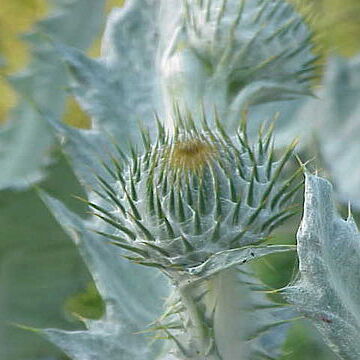Biennial herbs. Stems either lacking or well-developed, erect, sparsely branched, longitudinally striate; wings present, spinose. Leaves oblong to ovate, pinnatilobed; margins with numerous spine-tipped lobes and lobules. Capitula sessile or pedunculate, homogamous. Median involucral bracts spine-tipped; margins entire or serrulate. Receptacle almost flat, without setae, prominently alveolate, glabrous. Corolla purple or white; tube filiform; lobes linear, glabrous or glandular. Anther filaments free, pilose. Style branches connate, erect. Achenes obovoid, angular, transversely rugulose, glabrous; apical rim absent or rudimentary. Pappus deciduous, of numerous barbellate or plumose (not in Australia) capillary bristles, basally united in a ring.
Coarse, branching biennial to 2 m, very strongly spiny, with broadly winged stem; herbage ± tomentose; lvs toothed or slightly lobed, sessile and decurrent, or the lower petiolate, the blade to 6 × 3 dm; heads 2.5–5 cm wide, the invol bracts all spine-tipped; achenes 4–5 mm, slightly compressed, transversely rugulose; pappus merely barbellate; 2n=34. A Eurasian weed, sparingly naturalized over much of the U.S. and s. Can. July–Oct.
Similar to Cirsium, differing chiefly in the receptacle, which is flat, fleshy, and honey-combed, often with short bristle-tips on the partitions, but not densely bristly; pappus-bristles naked or plumose; spiny biennials, mostly tomentose or woolly. 40, sw. and c. Asia.

